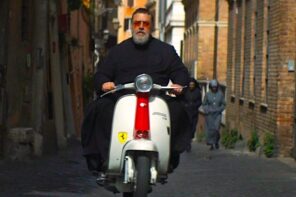Acclaimed Mexican poet and essayist Javier Sicilia traveled to Rome this past Saturday on a sacred mission. Accompanied by several fellow peace activists, Sicilia carried with him a very personal letter, addressed to Pope Benedict on the occasion of the pontiff’s upcoming apostolic visit to Mexico (March 23-26).
Hundreds of thousands of Catholic faithful are expected to descend on the Mexican heartland city of León, Guanajuato in coming days, where Benedict will hold several large public masses, meet with Mexican bishops, and discuss religious policy issues with President Felipe Calderón. The event marks the first papal visit to Mexico since 2002, led by then-Pope John Paul II. By all accounts, this might be the only voyage that 84-year-old Benedict XVI makes to the country. And for the Vatican, the trip is indisputably important.
Latin America is host to approximately half the world’s population of Catholics. In 2007, Benedict made his first appearance in the region as pope, attending the once-a-decade Latin American bishops conference held in Aparecida, Brazil. There, he outlined the contours of the Holy See’s mission of “New Evangelization,” poised to bolster an institution losing its grip on the region’s cultural identity. Thus, the pope arrives in Mexico this week to address the Latin American Church at a crossroads. Inroads made by Protestant, especially Pentecostal, proselytism have eroded the once near religious monopoly of the Catholic faith in the region, even while the twin enemies of “secularism” and “modernization” haunt the dreams of the Vatican’s Eurocentric hierarchy.
For Sicilia, a grieving father whose son was murdered by thugs last year, the pope’s visit is historic as well. Yet for him, and for those wounded voices he seeks to amplify, the pontiff’s arrival has less to do with pushing back secularism than with long-overdue attention to the ravages of Mexico’s drug wars.
“Poetry Doesn’t Exist in Me Anymore”
Sicilia’s letter implores the pope to intercede on behalf of drug war victims—50,000 in the past five years, with another 20,000 “disappeared,” and a quarter of a million displaced. “When you get to Mexico, dear Benedict,” Sicilia writes,
“we remind you of the body of Christ erased behind the media and political spectacle always mounted for you while those claiming to represent the word of God and those claiming to represent the word of the people hold it captive in the dock of the accused.”
Sicilia’s letter, written from one father to another, asks for the pope’s ear. But will he listen?
The road that led Javier Sicilia to Rome began with his own personal Golgotha. A well-regarded author, Sicilia won the prestigious Premio de Poesía Aguascalientes in 2009 for his collection of poetry entitled Desert Triptych. He has also written novels; many of them suffused with allusions to, and influenced by, his deep Catholic faith.
In March of 2011, Sicilia’s 24-year-old son Juan Francisco—an innocent—was tortured and murdered by drug traffickers in their home city of Cuernavaca, Morelos. Javier Sicilia received the heartbreaking news while attending a conference in the Philippines. He recalls chain-smoking a pack of cigarettes after hearing the report, unsure of his next move.
On returning to Mexico, Sicilia laid his son to rest. At the memorial he read a poem:
The world is not worthy of words
they have been suffocated from the inside
as they suffocated you, as they tore apart your lungs…
the pain does not leave me
all that remains is a world
through the silence of the righteous,
only through your silence and my silence, Juanelo.
As the memorial ended, Sicilia told the mourners gathered that this would be the last poem he would write. “Poetry doesn’t exist in me anymore,” he later claimed. But through his grief, Sicilia continued on, motivated now to give voice to the victims of Mexican drug violence.
Hasta la Madre
Just a week later, Sicilia again took up his pen and wrote an open letter to President Calderón titled “Estamos hasta la Madre!” (“We’ve had it up to here!”). In an interview with Time magazine, who named Sicilia among its notable people in its “Year of the Protester” issue, Sicilia explained the religious dimension of his language:
“On the one hand, yes, hasta la madre is Mexican slang, but it has a very religious component as well. The mother, like the Virgin of Guadalupe, is sacred. To say you’re hasta la madre means they’ve insulted our mother protector; they’ve committed a sacrilege. It’s very strong, very Mexican, but very poetic too in its own way. Anyway, it resonated in ways that exceeded my expectations.”
On the heels of this letter, Sicilia helped organize several peace marches, the first—some 200,000 strong—was initiated in Cuernavaca and traveled to Mexico City’s main square, the Zócalo, where marchers demanded that the government pay attention to the victims of the drug war. Until that point, President Calderón and his administration had claimed that the vast majority of those being killed in Mexico were complicit in drug crime. The innocent death of Sicilia’s son, and the sons, daughters, brothers, and fathers of so many others, belied the government’s line. The victims were not all delinquents—many of them were simply caught in the crossfire.
Approximately 40,000 Mexican soldiers have been deployed to fight the cartels, especially along the border in cities such as Ciudad Juárez and Tijuana. Rampant human rights violations have been reported, carried out by the very soldiers sent to protect Mexico’s citizens. The U.S.-backed Mérida Plan has invested millions of dollars into equipping the Mexican military with guns and weaponry. Despite the efforts of both governments, illegal guns and laundered money continue to flow south and illicit drugs go north, fueling America’s insatiable habit.
Sicilia’s Movement for Peace with Dignity and Justice offers a channel for popular rage, and calls for alternative solutions. A bus caravan of peace activists led by Sicilia traveled throughout Mexico in the summer of 2011, seeking to raise awareness and give a face to Mexico’s suffering. At rallies in cities such as Morelia, Durango, Torreón, Monterrey, and Ciudad Juárez, loved ones held pictures of the dead, putting a human face on Mexico’s grief. Sicilia’s loss has resonated with many other parents whose children have become victims.
Over the months since Sicilia initiated the movement, the poet has highlighted the importance of faith in coming to terms with his own loss: “I still believe, but these days it’s a naked belief, it’s a belief that’s in a very dark place. I can’t really comprehend or rationalize it right now, because my grief has been so all-consuming—but the faith is still there inside me.” It is this profound faith that motivated Sicilia to write the pope, hoping that his presence might console a troubled nation.
A Culture War Laundry List
It is no coincidence that the coming Easter season prompted Sicilia’s impassioned plea for papal solidarity. The poet compares Mexico to the broken body of Christ, beaten, abandoned, and left for dead:
“In their name, for this us, for this body, I have come to Rome, Benedict, to ask that in your visit to Mexico you embrace it, before anyone, as the Father embraced the pained and murdered body of Christ, that you might carry it in your arms and console it: to help us know the response of resurrection in the face of death and pain that the criminals, a fractured State administered by governments and corrupt parties and a Church hierarchy that seems always attentive to its own political interest, have imputed to us.”
What Sicilia and his companions ask is that the pope come to Mexico not as head of a political state, but as a pastor of souls—although this might be too much to ask. Mexico’s ambassador to the Vatican, Héctor Federico Ling Altamirano, has said that the pope’s agenda will touch on the family, abortion, euthanasia, stem-cell research, and the morning-after pill.
The subjects read like a list of culture war policies.
The pope and president will also talk about further changes to the Mexican Constitution, especially religious provisions in Article 24 that limit public manifestations of Catholic worship. The Constitution, written in the wake of the 1910 Revolution, contained many anticlerical provisions that helped provoke the three-year Catholic civil war known as the Cristero Rebellion (1926-1929). Many of the most onerous provisions were changed in the early 1990s, but Catholic leaders hope to finish the job.
The pope hopes to galvanize the Church against creeping secularization, while the president would like to use the papal visit to shore up support for his flagging political party, which most pundits project to lose in this summer’s general elections.
Vatican officials have announced that Sicilia will be met in Rome on Thursday by Mario Toso, secretary of the Church’s Pontifical Council for Justice and Peace. No plans have been made for a private audience with the pope. It remains to be seen what Benedict will say when he arrives in Mexico. His predecessor, John Paul II, was much loved by many Mexican Catholics and went to great lengths to encourage devotion to the Virgin of Guadalupe. One famous painting, still visible in Mexico, shows John Paul II embracing the Virgin, with his head laying softly on her breast.
Benedict XVI has a chance to recapture the sacred vision of those striving for peace in a besieged land, embracing and consoling those who mourn—but this kind of pastoral care may not be on the agenda.




